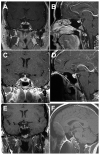Hypophysitis: Defining Histopathologic Variants and a Review of Emerging Clinical Causative Entities
- PMID: 36982990
- PMCID: PMC10057821
- DOI: 10.3390/ijms24065917
Hypophysitis: Defining Histopathologic Variants and a Review of Emerging Clinical Causative Entities
Abstract
Inflammatory disease of the pituitary gland is known as hypophysitis. There are multiple histological subtypes, the most common being lymphocytic, and the pathogenesis is variable and diverse. Hypophysitis can be primary and idiopathic or autoimmune related, or secondary to local lesions, systemic disease, medications, and more. Although hypophysitis was previously accepted as an exceedingly rare diagnosis, a greater understanding of the disease process and new insights into possible etiologic sources have contributed to an increased frequency of recognition. This review provides an overview of hypophysitis, its causes, and detection strategies and management.
Keywords: adrenocorticotrophic hormone; hypophysitis; immune checkpoint inhibitors; pituitary; pituitary gland.
Conflict of interest statement
The authors declare no conflict of interest.
Figures



References
-
- El Sayed S.A., Fahmy M.W., Schwartz J. Physiology, Pituitary Gland. StatPearls; Treasure Island, FL, USA: 2022. - PubMed
-
- Prete A., Salvatori R. Hypophysitis. In: Feingold K.R., Anawalt B., Boyce A., Chrousos G., de Herder W.W., Dhatariya K., Dungan K., Hershman J.M., Hofland J., Kalra S., et al., editors. Endotext. MDText.com, Inc.; South Dartmouth, MA, USA: 2000.
Publication types
MeSH terms
LinkOut - more resources
Full Text Sources

